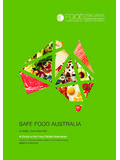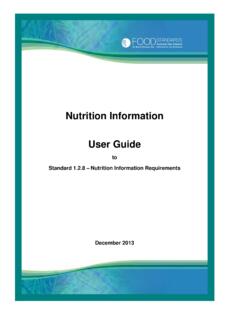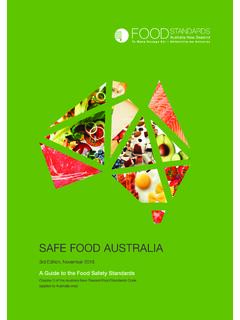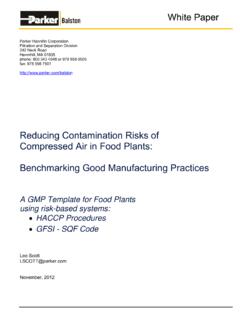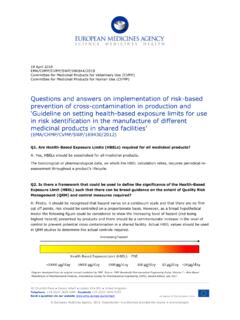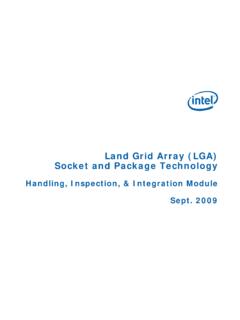Transcription of Appendix 6: Cleaning and sanitising surfaces and utensils
1 173 AUSTRALIA NEW ZEALAND FOOD STANDARDS CODE CHAPTER 3 (AUSTRALIA ONLY)APPENDICESFOOD STANDARDS AUSTRALIA NEW ZEALAND SAFE FOOD AUSTRALIA6 Appendix 6 Appendix 6: Cleaning and sanitising surfaces and utensilsThis Appendix includes information on Cleaning and sanitising eating and drinking utensils and food contact surfaces . It is for information only and businesses are not legally obliged (under the food safety standards) to clean and sanitise at the temperatures or times specified and sanitising are separate procedures, and sanitising is distinct from is a process that removes visible contamination such as food waste, dirt and grease from a surface, usually using water and detergent.
2 During the Cleaning process, microorganisms will be removed but the Cleaning process is not designed to destroy is a process that destroys microorganisms, reducing the numbers present on a surface to a safe level. This is usually achieved by the use of both heat and water, or by specific sanitising chemicals (detergents are generally not sanitisers).Sterilising is a process designed to destroy all microorganisms including microorganisms that have formed a protective coat (spores). The standards do not require eating and drinking utensils and food contact surfaces to be and sanitising should usually be done as separate processes.
3 A surface needs to be thoroughly cleaned before it is sanitised, as sanitisers generally do not work well in the presence of food residues and six recommended steps for effective Cleaning and sanitising are:1. Pre-clean: scrape or wipe food scraps and other matter off surfaces and rinse with Wash: use hot water and detergent to remove grease and food residue. (Soak if needed.)3. Rinse: rinse off detergent and any loosened Sanitise: use a sanitiser to destroy remaining microorganisms (refer to manufacturer s Final rinse: wash off the sanitiser if necessary (refer to manufacturer s instructions).)
4 6. Dry: allow to drip dry or use single use and sanitising can be done manually ( using spray bottles or sinks), or using dishwashers or other specialised equipment, depending on the size and number of items to be cleaned and sanitised. An example of a simple double sink arrangement that may be suitable for small amounts of utensils or small equipment is illustrated GUIDE TO THE FOOD SAFETY STANDARDS THIRD EDITION NOVEMBER 2016 FOOD STANDARDS AUSTRALIA NEW ZEALAND SAFE FOOD AUSTRALIAFOOD STANDARDS AUSTRALIA NEW ZEALAND SAFE FOOD AUSTRALIA6 Appendix 6 Figure: Example of Cleaning and sanitising using a double sink.
5 (The 2nd sink could alternatively have water at 77 C or hotter if no sanitiser chemical is used.) CleaningThe thorough Cleaning of eating and drinking utensils and food contact surfaces is a critical step before sanitising . Food businesses must use a Cleaning process that ensures the utensil or food contact surface looks clean, feels clean and smells cleaningFor effective Cleaning , the following factors should be considered: Warm to hot water is generally needed Heated water will help remove grease or fat but the temperature should not be so hot that it bakes food residue onto the surface.
6 For example, 54 C to 60 C has been recommended (Mallman et al 1947) for washing utensils as higher temperatures tend to bake on food residues. Detergents should be appropriate for the task For example, household detergents may suffice for small-scale manual washing, but specialised detergents may be needed depending on the residue to be removed and the equipment being used. Detergents containing sanitisers are not required If such a detergent is used, advice on whether it can clean and sanitise to the required standard should be sought from the manufacturer or supplier.
7 The use of a mechanical washer for large volumes of washing up is preferred Studies have found that mechanical washing is consistently more effective than washing up by hand ( Sigua et al 2011). Cleaning without water may be necessary in some situations. Whatever method is used it must achieve the intended outcome: that is, that the utensil or surface looks clean, feels clean and smells NEW ZEALAND FOOD STANDARDS CODE CHAPTER 3 (AUSTRALIA ONLY)APPENDICESFOOD STANDARDS AUSTRALIA NEW ZEALAND SAFE FOOD AUSTRALIA6 Appendix 6 SanitisingSanitation of eating and drinking utensils and food contact surfaces should only be done after they have been thoroughly cleaned; otherwise it may not be effective.
8 sanitising can be achieved through the use of hot water, chemicals or other processes. Some examples are: soaking items in very hot water (see below) soaking items in diluted bleach (see below) saturating items with 70% alcohol applying a commercial food-grade sanitiser according to the manufacturer s instructions, with particular attention to the required concentration and contact sanitationFor effective sanitation, the following factors are important: All surfaces to be sanitised must be clean, since sanitisers generally do not work well in the presence of food residues or other soil.
9 Sanitisers should be used at the correct concentration (too low or too high is not effective) and temperature and for the correct contact time. Ideally, details will be specified by the sanitiser s manufacturer. Using products with informative labels or product specification sheets will enable details of use to be easily checked. Some sanitisers require extended contact time to ensure pathogens are reduced to a safe level. Diluted sanitisers often have a shorter shelf life than the concentrated form, so this should be checked before use, and a fresh batch made if needed.
10 All surfaces to be sanitised should be completely covered with the sanitising solution, using a dip or spray. Special attention should be given to equipment with surfaces that are difficult to get at, such as stab mixers, blenders, meat slicers and can openers. Equipment may need to be dismantled to gain proper access to the surfaces that need to be sanitised. After sanitising , utensils and surfaces should be thoroughly dried. If used while still wet, there is a greater chance that they could pick up dirt or other contaminants. Air drying is preferable.


